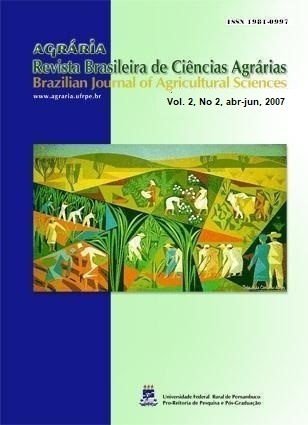Analysis of the vegetation in abandoned fields in the ‘Agreste Paraibano’
DOI:
https://doi.org/10.5039/agraria.v2i2a40Keywords:
caatinga, natural regeneration, ecological successionAbstract
It was aimed to study ecological succession in an old Sisalana field, abandoned 30 years ago, in the municipality of Pocinhos, Paraíba. In 20 plots (10 x 20 m), DNS (Diameter at the Soil Level) and the individual’s total height were taken. The difference between adults and natural regeneration was made by DNS. For natural regeneration four size classes were established: Class I: 0.3 – 1.49 m; Class II: 1.5 – 2.49 m; Class III: 2.5 – 3.0 m and Class IV: bigger than 3 m and DNS < 3 cm. The value of Shannon diversity index was of 2.16 and the total basal area was 23.85 m2.ha-1. Adult species that showed high values of importance (VI) were: Pilosocereus glaucescens (Labour.) Byles, Pithecellobium diversifolium G.P. Lewis, Caesalpinia pyramidalis Tul. and Schinopsis brasiliensis Engl. The first species contributed with 27% of the total VI. The Classes I and II got 45 and 41% of the young individuals, respectively. It is conchuded that the period of 30 years, after abandoning crop was enough for the restoration of the native vegetation, whose diversity and structure are compatible with
the caatinga in regional context.



